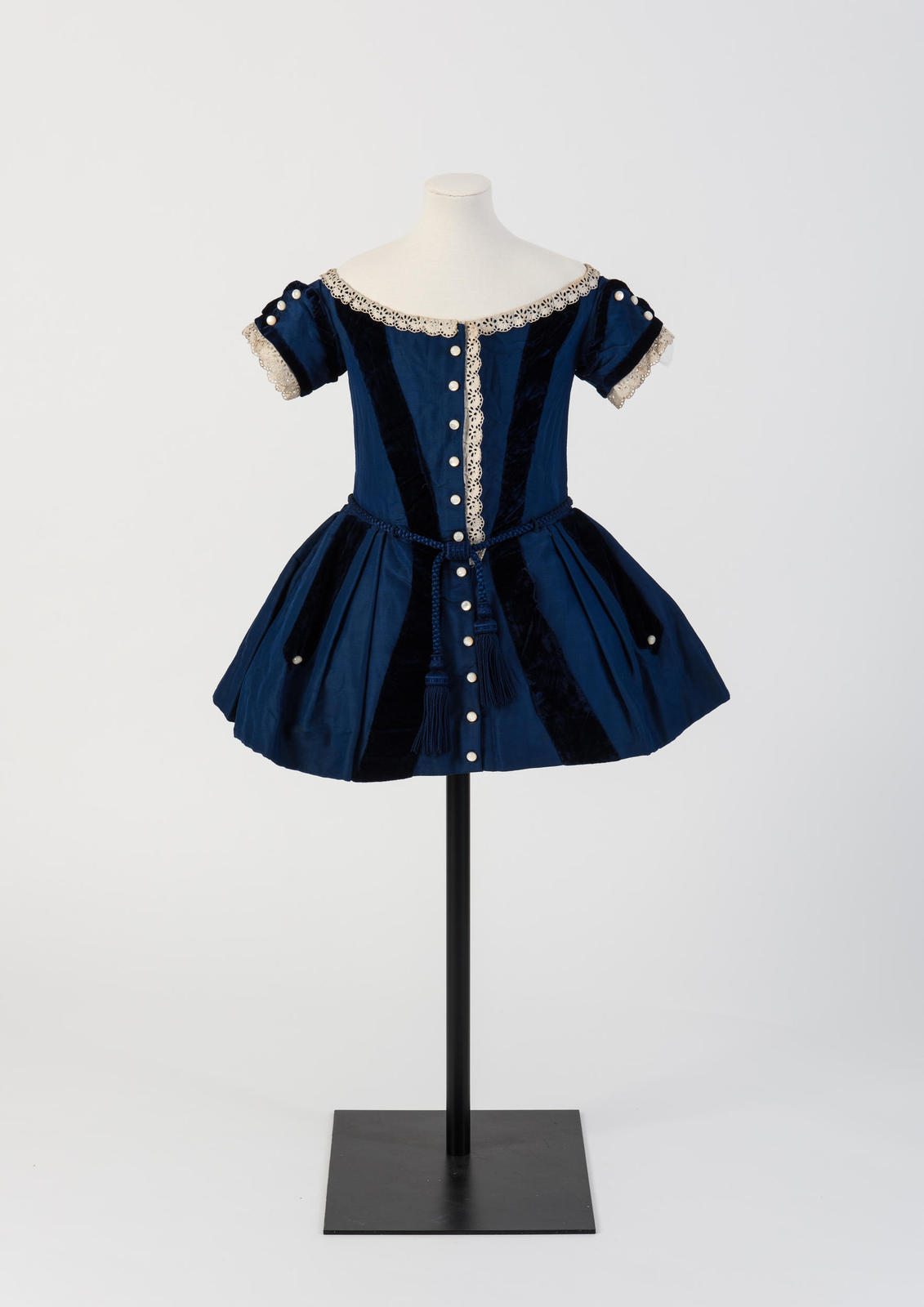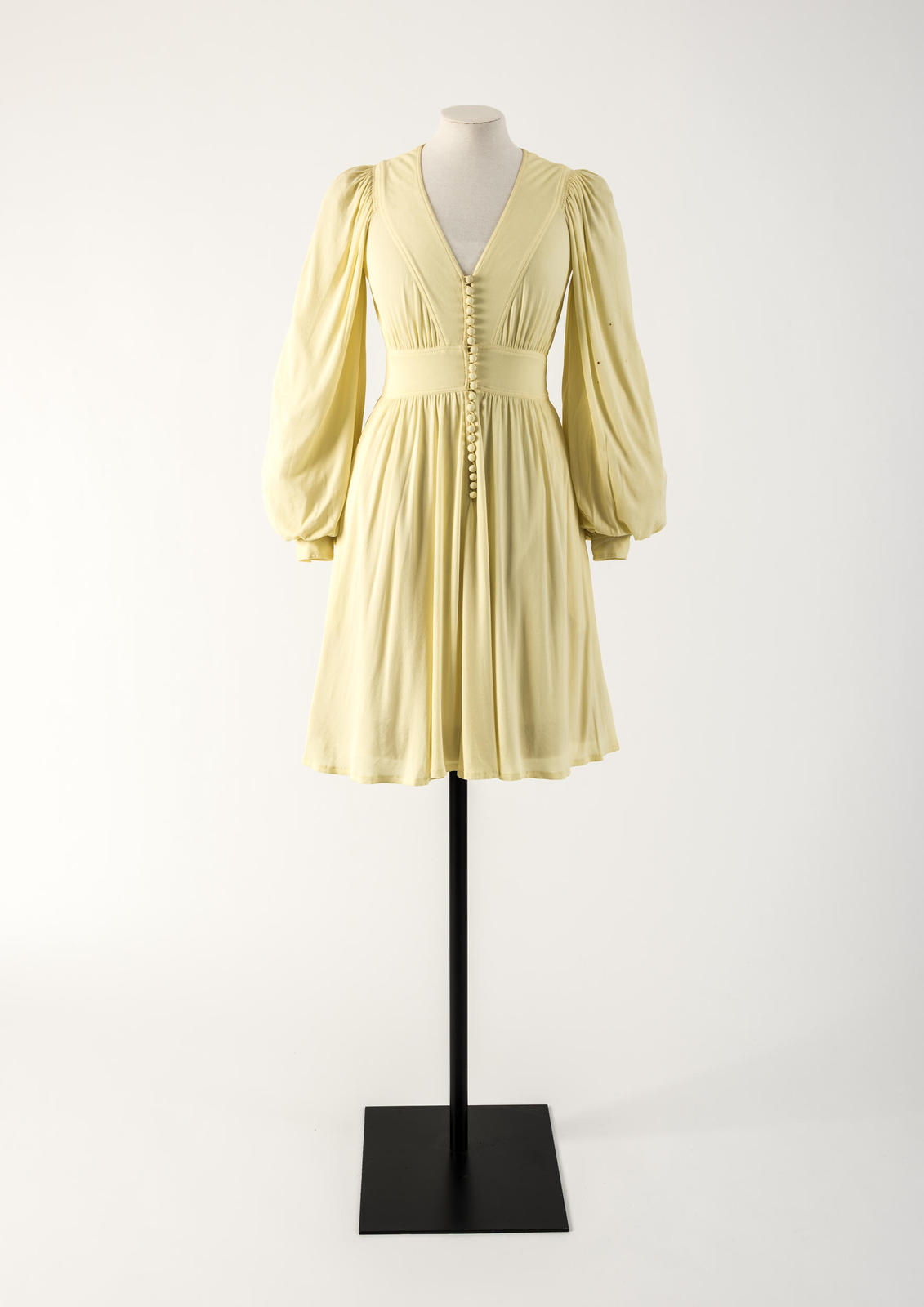On display at Fashion Museum in Bath (UK) until January 2019, A History of Fashion in 100 Objects celebrates fashion from the 1600s to the present day. Address contributor Pat Francis visited the exhibition and eventually responded to it using 100 words.

Yellow and gold woven silk robe à la française, 1760s. Source: Fashion Museum, Bath
What is a fashion object: to be seen and touched, or subject of thought, or object of derision? In these 100 stars of the Fashion Museum’s collection, all aspects of ‘objects’ are evident: ridiculous, inspiring, shocking and clearly contextualised. The events of history, politics, war, mechanisation, liberation (whether materials or convention) – all are shown. Interspersed are 10 collections of shoes/boots that accessorise our social perambulations and 10 children’s pieces which reveal the growing up of fashion or the infantilisation of women. But in the end, does fashion ever grow up or liberate? The rules are as demanding now as they always were; the processes never free the workers or the consumers. Huge questions remain – the repulsive, whole pheasant on a hat which led to Queen Alexandra leading a campaign against the over-use of exotic bird feathers which was causing the extinction of species, to the excessive plastic in the 2014 piece of Pugh. Issues of labour and thoughtless consumption: horrendous factory conditions throughout the world cannot be ignored. Although the title might seem to limit this telling of history (only 100 objects for the 500 years covered) – in fact it does the reverse. It opens up debate and intrigue – what is missing, who is missing; how do we look back and do we look forward?

Man’s cream silk satin embroidered coat and pink silk breeches, 1780s, Source: Fashion Museum, Bath
What is an object?
I could object to some of the collection (and do), and the main purpose of my activity – the object of my intention in writing about it, is to provoke, intrigue and baffle…

Blue wool and silk boy’s frock, 1850s. Source: Fashion Museum, Bath
Four columns represent
descriptive or reflective response/object/information/date

Lemon yellow rayon jersey dress with row of domed buttons. Jean Muir, 1974. Source: Fashion Museum, Bath
A Hundred History Harpings
- overblown, nightgown, voluminous, 1600s
- informal, sleeveless, waistcoat, unconventional, 1610s
- embroidered, nightcap, functional, 1610s
- three-piece, waistcoat, practical, 1690s
- pretty, petticoat, worn to be seen, 1690s
- quality, waistcoat, seems 2-Dimensional, 1700s
- revealing, open robe, brocade, 1730s
- reserved, closed robe, draw loom, 1740s
- shapely, man’s waistcoat, flat planels, 1740s
- quilted, petticoat, warm, 1740s
- pinned, stomacher, bold, 1740s
- faceless, man’s suit, traditional, 1750s
- hooped, open robe, movement, 1760s
- warming, cape mantle, swinging, 1760s
- loose, robe a la francaise, sacque, 1760s
- anonymous, man’s suit, suit, 1770s
- chintzy, banyan, artists/writers, 1750s
- fabulous, robe a la francaise, sack back, 1770s
- excessive, robe a la anglaise, en fourreau, 1770s
- pocketed, sack back dress, pocket hoops, 1770s
- pale-tight, man’s suit, macaroni, 1780s
- intolerable, stays, ‘ton – pride feels no pain’, 1780s
- puffed, closed gown, bouffon, 1780s
- labouring, man’s frock coat, Rousseau: back to nature, 1790s
- printed, gown, industrialisation, 1790s
- muslin, gown, pat tea motif, 1800
- neo-classical, gown, chemise de la reine, 1800
- woollen, gown, two-piece, 1815
- spotty, frock, frock not gown, 1816
- gauze, frock, Madras lace, 1817
- merino, man’s trousers, pantaloons, 1820s
- scalloped, cotton dress, hand to machine embroidery, 1824
- tea-ground, printed dress, roller printed, pale brown, 1825
- puffed, silk dress, leg of mutton gigot, 1835
- exquisite, white work collar, Ayrshire, 1830s
- dandy-less, man’s suit, end of dandyism, 1830s
- white, wedding dress, link to Queen Victoria, 1840s
- modest, bonnet, straw, but fabric covered, 1840s
- geometric, dress, huge pompoms, 1840s
- flouncy, dress, woven a la disposition, 1850s
- precise, top hat, Beaver fur, 18150s
- paisley, shawl, jacquard, 1850s
- delicate , dress, crinole, intricate, 1860s
- lacy, dress, Bucks Point lace, 1865
- hybrid, Dolman, part coat/cape pashmina, 1870s
- décolletage, evening dress, polonaise, 1870
- ruled, day dress, etiquette, 1874
- craped, mourning dress, rules and requirements, 1880s
- bustled, bustle dress, in and out of fashion, 1886
- aesthetic, dressing gown, Aesthetic movement, 1880s
- japonisme, fan, oriental influence, 1890s
- adornment, accessories, adorned to extinction, 1800s
- constructed, day dress, Worth, 1890
- for-best, corset, show, 1890s
- liberating, riding habit, New Woman, 1890s
- trained, court gown, Welborn of Regent Street, 1900
- tailored, jacket, precise tailor-made, 1905
- dustered, chauffeur’s coat, Alfred Dunhill Ltd, 1900s
- pheasanted, hat with whole bird, Queen Alexandra against, 1911
- symbolic, parasol, belonged to suffragette, 1912
- Titanic, wedding dress, Lucile – Lady Duff Gordon, 1908
- utilitarian, nurse’s apron, timeless, 1914
- ankled, coat and skirt, Dickens & Jones 1st ankle, 1916
- fiery, fancy dress, flames of hell, 1927
- beadjangled, beaded dress, Paquin, 1927
- chiche, cloche hat, chic and fitted, 1928
- absurd, beach pyjamas, silky, 1929
- cross grained, evening gown, Donguy, 1930s
- suave, man’s evening dress, tuxedo, 1930s
- ostentatious, fur coat, Molyneux mink, 1930s
- synthetic, wedding dress, new material, 1940
- celebratory, party dress, bolero for VE party, 1945
- rational, Utility suit, regulated, 1947
- flamboyant, New Look suit, Dior, 1947
- starry, jacket, Lelong for Vivien Leigh, 1948
- idealised, fashion doll, Miss Virginia Lachasse, 1954
- exposed, dancing dress, halter neck, 1954
- home made, crochet blouse, Coats pattern, 1950s
- flirty, nylon petticoat, lingerie, 1950s
- noisy, beaded dress, Hartnell/Elizabeth Taylor, 1958
- naughty, knickerbocker dress, youthquake Mary Quant, 1961
- arty, Mondrian dress, YSL for Fonteyn, 1965
- dapper, man’s suit, Blades/Fish for Roy Strong, 1968
- inappropriate, beach wear, acrylic crochet, 1969
- classic, dress, Jean Muir rayon jersey, 1974
- bifurcated, trouser suit, Missoni, 1970s
- celebrity, ballgown, The Emmanuels, 1982
- ubiquitous, jeans, Fiorucci, 1983
- bombshell, man’s coat, Blitz Willie Brown, 1980
- leggy, man’s jacket & shorts, JPG, 1991
- patriotic, evening dress, Lauren, 1991
- must-have, newsprint gloves, Galliano, 2000
- shorted, man’s suit/shorts, Thom Browne, 2006
- bodycon, Galaxy dress, Mouret, 2015
- hyper-fruity, head piece, Piers Atkinson’s cherries, 2015
- confectionery, evening dress, Sarah Burton for McQueen, 2011
- retro, embroidered dress, Raf Simons, 2012
- taped, Applique dress, Christopher Kane, 2013
- shrink wrapped, plastic ensemble, Gareth Pugh, 2014
- ungendered, quilted ensembles, Craig Green, 2015

Iridescent layered plastic ensemble, Gareth Pugh. Source: Fashion Museum, Bath

